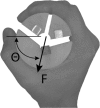Reliability and validity of the multiaxis profile dynamometer with younger and older participants
- PMID: 20456919
- PMCID: PMC2910144
- DOI: 10.1016/j.jht.2010.02.002
Reliability and validity of the multiaxis profile dynamometer with younger and older participants
Abstract
Study design: Clinical Measurement.
Introduction: Grip strength has been administered for many years with a wide variety of instruments and for very different purposes.
Purpose of the study: To examine the reliability and validity of a new grip measurement device, the multiaxis profile (MAP) dynamometer, compared with the Baseline dynamometer (Fabrication Enterprises Inc., White Plains, NY) and vigorimeter.
Methods: Twenty-eight participants (<30 yr, n=14; and >65 yr, n=14) completed grip strength testing using all three devices. Measurements were obtained at baseline and one to two weeks later.
Results: Intraclass correlation coefficients (ICCs) for the MAP ranged from 0.94 to 0.99. The other two devices had ICCs of 0.95-0.98. Correlations among the MAP dynamometer, the Baseline dynamometer, and the vigorimeter were 0.78-0.90. The results indicate high concurrent validity among all the three devices and that all devices are reliable instruments to measure the grip strength of both younger and older adults.
Conclusions: In addition to measuring grip strength, the MAP dynamometer measures other grip-related information, such as grip force vectors, rate of force buildup, and force variability. This additional grip information may improve our understanding of hand function and changes because of aging.
Level of evidence: n/a.
Copyright © 2010 Hanley & Belfus. Published by Elsevier Inc. All rights reserved.
Figures






References
-
- Mathiowetz V, Vizenor L, Melander D. Comparison of baseline instruments to the Jamar dynamometer and the B&L engineering pinch gauge. Occup Ther J Res. 2000;20:147–162.
-
- Mathiowetz V, Kashman N, Volland G, Weber K, Dowe M, Rogers S. Grip and pinch strength - normative data for adults. Arch Phys Med Rehabil. 1985;66:69–74. - PubMed
-
- Gunther CM, Burger A, Rickert M, Crispin A, Schulz CU. Grip strength in healthy Caucasian adults, reference values. J Hand Surg-Am Vol. 2008;33A:558–565. - PubMed
-
- Vlieland T, vanderWijk TP, Jolie IMM, Zwinderman AH, Hazes JMW. Determinants of hand function in patients with rheumatoid arthritis. J Rheumatol. 1996;23:835–840. - PubMed
-
- Tremayne A, Taylor N, McBurney H, Baskus K. Correlation of impairment and activity limitation after wrist fracture. Physiother Res Int. 2002;7:90–99. - PubMed
Publication types
MeSH terms
Grants and funding
LinkOut - more resources
Full Text Sources
Medical
Research Materials

